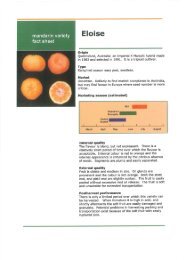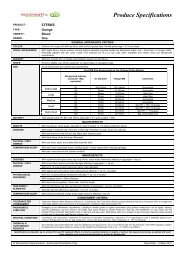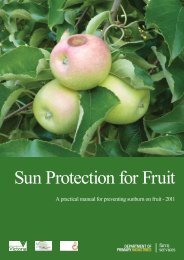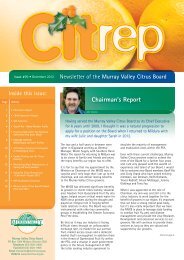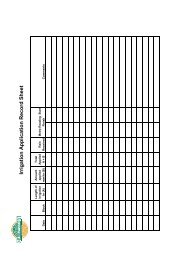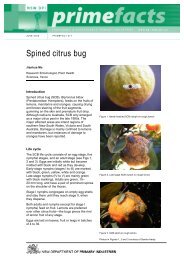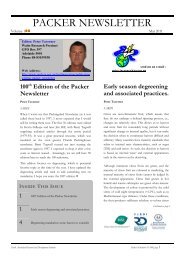TAHITIAN LIME(Persian
TAHITIAN LIME(Persian
TAHITIAN LIME(Persian
You also want an ePaper? Increase the reach of your titles
YUMPU automatically turns print PDFs into web optimized ePapers that Google loves.
<strong>TAHITIAN</strong> <strong>LIME</strong> (<strong>Persian</strong><br />
Lime)<br />
Limes have many uses, including jams, jellies, marmalade and garnishing fish<br />
and other main dishes. The fruit is sold commercially as fresh fruit and also<br />
for processing although the Tahitian lime is preferred as fresh fruit because it<br />
is considered unsuitable for lime cordial products.<br />
The name “Tahitian” was given to the lime when the fruit was introduced from<br />
Tahiti to California. However, with the introduction of this variety into<br />
Australia in 1824 (possibly from Brazil) the fruit was then more commonly<br />
called the <strong>Persian</strong> lime.<br />
DESCRIPTION<br />
Large sized lime, generally 5 - 7 cm long and 4 - 6 cm in diameter.<br />
Colour of the fruit is green and pale lemon/yellow at maturity. The fruit has a<br />
distinct lime flavour and a moderate to high acidic level. The flesh at maturity<br />
is green and pulpy. Sold mainly as fresh fruit, Tahitian limes rarely have<br />
seeds and are excellent for growing in many areas of Australia.<br />
PRODUCTION OF <strong>LIME</strong> TREES<br />
Main crop harvest will vary with seasonal conditions and districts.<br />
January to March on the far North Coast areas.<br />
February to March on the Central Coast.<br />
April to July in cooler districts.<br />
The trees have little thorns and are moderately vigorous, growing from 2 to 4<br />
metres high. Size depends on soil and rootstocks.<br />
Lime trees have the highest heat requirements of all citrus fruits and<br />
therefore grown in tropical or sub-tropical areas where better fruit quality is<br />
obtained.<br />
The trees grow continuously and are sensitive to cold. The Tahitian lime is<br />
slightly more cold resistant than other varieties, however frosts can damage<br />
both foliage and fruit.<br />
PROPAGATION AND ROOTSTOCKS<br />
Rough lemon and Poncirus Trifoliata have proved satisfactory for Tahitian<br />
limes in small commercial plantings and in home gardens. Poncirus Trifoliata<br />
rootstocks produce smaller trees than the rough lemon and can therefore be<br />
planted closer together.
Page 1<br />
PLANTING<br />
Requirements for soils are similar to those of lemons. Good drainage is<br />
essential and a soil PH in the range of 5.5 to 7.5, according to the rootstock<br />
used. If Citrus Nematode, alkalinity and salinity are present then<br />
consideration should be given to site preparation and selection of rootstock.<br />
Tahitian limes require tree spacing of 3 to 4 metres within the row and 5 to 6<br />
metres between rows under coastal conditions. 412 to 632 trees per<br />
hectare. If there is a risk of early or late frosts, planting should be done in the<br />
spring to allow the trees to become established.<br />
Trees should be planted with the bud union well above ground level. Form a<br />
basin around the planted tree and apply about 10 litres of water to remove air<br />
pockets and consolidate the soil.<br />
NUTRITION<br />
Requirements differ according to soil types. Generally, in the non-bearing<br />
period, lime trees will require some nitrogen, phosphorus and some<br />
potassium fertiliser at rates similar to those for non-bearing lemons.<br />
Young trees may need nitrogen in three separate applications through the<br />
growing season and phosphorous in one application. Potassium may be<br />
required for sandy soils with a low clay content.<br />
Mature trees require fertilising at about 50 per cent the rate for mature lemon<br />
trees. Base all applications on foliage observations and analysis, taking into<br />
account cropping, tree density, soil type and rootstocks.<br />
HARVESTING<br />
Limes for the fresh fruit market should be selectively hand picked from the<br />
trees. Processing fruit is allowed to fall from the trees when mature and can<br />
be harvested from the ground.<br />
Limes are not suitable for long cold storage. Prolonged exposure to the cold<br />
can result in the development of yellow rind colour. Tahitian limes may be<br />
temporarily stored for 6 to 8 weeks in controlled cold storage.
Page 2




